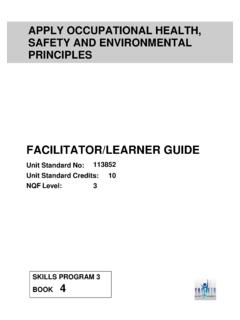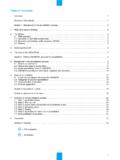Transcription of USE SECURITY EQUIPMENT - OSHA
1 USE SECURITY EQUIPMENT facilitator /LEARNER GUIDE Unit Standard No: 244176 Unit Standard Credits: 2 NQF Level: 2 skills PROGRAM 1 BOOK 4 2 3 REVIEW AND ALTERATION OF TRAINING MATERIAL What follows is a brief explanation of the process that was followed in the alteration of this training material. A working group was formed after inviting interested parties to attend a meeting at SASSETA. The working group was mandated to review the material and thereafter make the necessary changes so as to provide the industry with a more user friendly set of materials which better reflects the needs of the SECURITY industry. It must be understood that this is the first review and by no means the final review.
2 The working group was placed under enormous pressure to get a workable set of materials into the hands of the accredited SECURITY industry training providers as quickly as possible. We therefore have no doubt that even though the materials have been vastly improved upon, there are still areas that may require change. This we plan to do in the next renewal phase after we receive feedback from training providers who have used the material for approximately a year. Our review process focused on the following: Removal of unnecessary information/duplication from the learning material. Ensure alignment with the unit standards. Re-draft all formative and summative assessments. Correct inappropriate use of language.
3 TASK TEAM The task team that completed the work on this training material deserves a very special thank you , considering that all their time and efforts were provided free of charge. Nobody was paid for any of the work done on behalf of the task team. SASSETA provided funding for the expenses incurred in printing, typesetting, lunch and refreshments. The task team members are as follows: Andre Pretorius International Firearm Training Academy Andre Wilken SSN Dave Dodge ESKOM Eddie Du Plooy/ Elvis Masera SBV Services Jean Du Plessis Lyttleton Firearm Training Centre Leon van Rooyen NAD Lionel Arries SASSETA (observer/adviser) Marion Colley Pexco SECURITY and Training A very sincere thank you to all of these individuals and the companies they work for, who allowed them to participate during business hours.
4 This could not have been done without your commitment. Sincerely Andre Pretorius Task Team Chairman 4 PROGRAM GUIDE 6-7 1. Introduction 6 2. Purpose of this learning program 6 3. Standards and qualifications 6 4. Assessments 6 5. SECURITY program matrix 7 Study unit 1: Batons 8-15 1. Introduction 9 2. Types of batons 10 3. The grip of the tonfa 11 4. The grip and carry positions of the straight baton 11 5. Defensive manoeuvres with the Tonfa 12 6. Defensive manoeuvres with the straight baton 14 7. Baton retention when a person reaches for your baton while you are in 15 8. Sparring 15 9. Legal guidelines 15 10. Safety guidelines 15 Study unit 2: Constraint apparatus 16-22 1. Definition 17 2. Description of handcuffs 17 3.
5 Types of handcuffs 17 4. The use of handcuffs 18 5. Perform an arm bar takedown and apply handcuffs. 20 6. Legal guidelines 21 7. Safety guidelines 22 Study unit 3: Defensive sprays 23-28 1. Introduction 24 2. Definition 24 3. Effects 24 4. How to use Mace Self Defense Spray 25 5. Safety guidelines 26 6. Spray patterns 27 Study unit 4: Two way radio communication 29-37 1. Introduction 30 2. Definition 30 3. Components of a two way radio 30 5 4. Radio procedures 30 5. Principles of voice procedure 31 6. The phonetic alphabet 33 7. Common words and phrases 34 8. Radio controls 34 9. Principles of radio procedures 37 Study unit 5: Metal detectors 38-45 1. Introduction 39 2. Definition 40 3. Searching with a hand held metal detector.
6 40 4. Operating a handheld metal detector 41 5. Practical use of the scanner 42 6. Legal guidelines when using a hand metal detector. 43 7. Safety guidelines. 43 8. Function and characteristics of Walk through metal detector. 43 Study unit 6: Body armor 46-52 1. What is body armor 47 2. Different types of body armor 47 3. Standards of body armor 47 4. The purpose of having body armor 50 5. Benefits of wearing Body Armor 50 6. Safety Instructions 52 7. Legal guidelines 52 Study unit 7: Flashlights 53-60 1. Introduction 54 2. How to use the flashlight 55 3. Changing the battery of the flashlight 57 4. Carry the flash light 58 5. Battery-powered vs. Re-chargeable? 59 6. Safety guidelines when using a flashlight.
7 60 Study unit 8: Maintenance of SECURITY EQUIPMENT 61-71 1. Safe storage of SECURITY EQUIPMENT 62 2. Basic maintenance check of SECURITY EQUIPMENT 62 3. Storage methods 70 4. Procedure for reporting defective EQUIPMENT 70 Unit Standard 72-74 Learner Workbook Section 75-82 6 1. Introduction This learning program is part of a complete qualification. The qualification is General SECURITY Practices NQF level 3. 2. Purpose of this learning program A person credited with this unit standard will be able to: Explain the safekeeping and storing of SECURITY EQUIPMENT . Demonstrate the use of SECURITY EQUIPMENT . Confirm the working condition of SECURITY EQUIPMENT . Target group This program is compiled for the following target group: SECURITY members South African Defense Force members South African Police Force members Correctional Services Individuals who wishes to complete the NQF level 3 National Certificate in SECURITY Practices.
8 3. Standards and qualifications Unit standards are the building blocks of qualifications. All qualifications are plotted on the National Qualifications Framework (NQF). Unit standards comprises of outcomes. An outcome is a statement that describes the required competency that must be demonstrated by the learner on successful completion of a training intervention. 4. Assessments The assessment criteria in this unit standard describes the evidence that is needed that will show that you have demonstrated the outcome correctly. Kindly refer to the unit standard attached hereto for the assessment criteria listed under each Specific Outcome in order for you to see what you will be assessed against.
9 You will be required to complete 2 written exams. The first is a formative assessment (open book exam) and the second is a summative assessment (closed book exam). The purpose of the formative assessment is to prepare you for the summative assessment. The learner guide will remain the property of the learner once the LEARNING PROGRAM has been completed. 7 5. SECURITY program matrix skills PROGRAM 1: SASSETA E 1 246694 Explain the requirements for becoming a SECURITY service provider Level 3 4 Credits 2 244184 Apply legal aspects in a SECURITY environment Level 3 8 Credits 3 244182 Give evidence in court Level 3 4 Credits 4 244176 Use SECURITY EQUIPMENT Level 2 2 Credits 5 244181 Perform hand over and take over responsibilities Level 3 2 Credits 6 244177 Conduct a SECURITY patrol in area of responsibility Level 3 7 Credits 7 244179 Handle complaints and problems Level 3 6 Credits 8 12484 Perform basic fire fighting Level 2 4 Credits 9 116534 Carry out basic first aid treatment in the workplace Level 3 2 Credits skills PROGRAM 2.
10 SASSETA D 1 244189 Conduct access and egress control Level 4 7 Credits 2 242825 Conduct evacuations and emergency drills Level 4 4 Credits 3 11505 Identify, handle and defuse SECURITY related conflict Level 4 12 Credits 4 117705 Demonstrate knowledge of the Firearms Control Act 2000 (Act No. 60 of 2000) Level 3 3 Credits 5 113924 Apply basic business ethics in a work environment Level 2 2 Credits 6 119465 Write/present/sign texts for a range of communicative contexts Level 3 5 Credits 7 114979 Operate a computer workstation in a business environment Level 3 2 Credits skills PROGRAM 3: SASSETA C 1 113909 Coach a team member in order to enhance individual performance in work environment Level 3 5 Credits 2 13912 Apply knowledge of self and team in order to develop a plan to enhance team performance Level 3 5 Credits 3 244578 Describe how to manage reactions arising from a traumatic event Level 3 2 Credits 4 113852 Apply occupational health.





